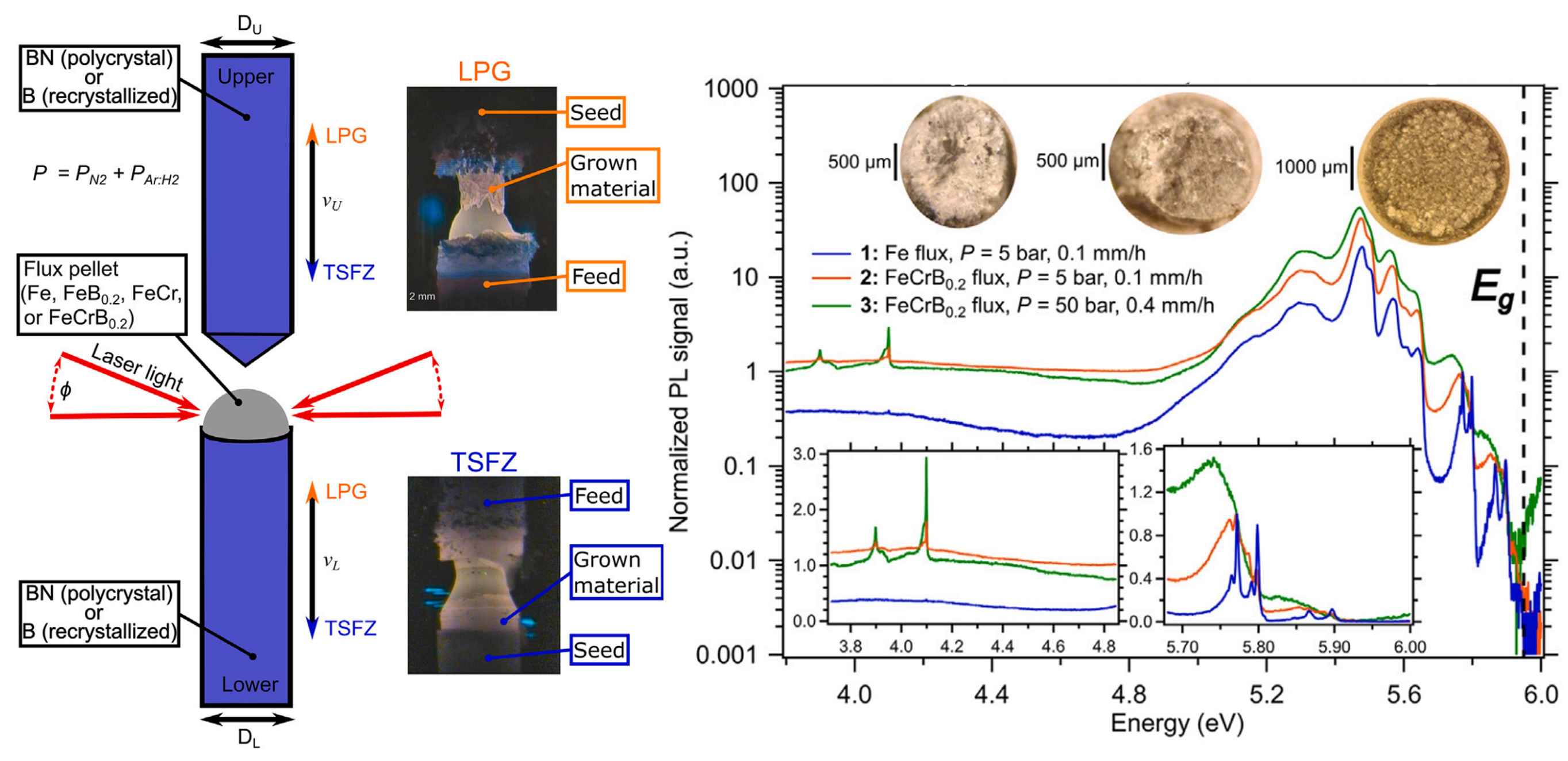PARADIM Highlight #108—External User Project (2025)
J.H. Edgar (KSU), G. Ye, C. Nnokwe, R. He (Texas Tech), R. Gomez, S.D. Wilson (UCSB), J. Plo, P. Valvin, B. Gil, G. Cassabois (Montpellier) and E. Zoghlin, A. Ferrenti, S. Kushwaha, T.M. McQueen (JHU)
Sophisticated electronic devices based on ultra-thin materials—two-dimensional materials that are as thin as a single atom—require bespoke materials to serve as substrate, insulator, or encapsulation. It has long been known that hexagonal boron nitride (h-BN) offers many of the sought-after properties. Recently, h-BN garnered interest in its own right, for applications in photonics, non-linear optics, quantum information science, and sensing technologies. Many of the advances were enabled by progress in the synthesis of large, high-purity single-crystals of hexagonal BN (h-BN) that are commonly made at high temperatures and GPa pressures.

Figure 1: (left) Solvent Laser Pedestal (LPG) and Traveling Solvent Floating Zone (TSFZ) of h-BN combines an intermetallic flux with a boron or boron nitride feed and nitrogen gas to enable controlled crystallization of h-BN without requiring extreme pressure. (right) optimized samples (blue) produced in this fashion have no observable in-plane defect photoluminescence at 3.9/4.1 eV. Well-resolved photon sub-bands at 5.8 eV, indicating quality at least as good as previous state of the art produced by high pressure methods, and now in larger crystal boule sizes than was previously possible. (Patent Pending)
Users of PARADIM set out to address several challenges associated with h-BN single crystal growth, namely increasing sample volume while maintaining high purity and crystallographic perfection. Starting from novel fluxes pioneered by the users, and applying the LPG and TSFZ methods, the team shows the successful growth of multi-mm scale h-BN crystals with excellent crystalline quality.
This work lays the foundation for new generations of scalable electronic devices that rely on h-BN.
Large, high-purity single-crystals of hexagonal BN (h-BN) are essential for exploiting its many desirable and interesting properties. Here, we demonstrate via X-ray tomography, X-ray diffraction and scanning electron microscopy that h-BN crystals can be grown by solvent laser pedestal (LPG) and traveling-solvent floating-zone (TSFZ). The diameters of grown boules range from 3 – 5 mm with lengths from 2 – 10 mm. Tomography indicates variable grain sizes within the boules, with areas of 1-2 mm and thickness 0.5+ mm. The current optimized growth procedure employs an Fe flux, moderate N pressure (6 bar), and a growth rate of 0.1 mm/h, with obvious paths for further optimization and scaling. Raman spectroscopy for an optimized sample gives an average linewidth of 7.7(2) cm−1 for the E intralayer mode at 1365.46(4) cm−1 and 1.0(1) cm−1 for the E interlayer shear mode at 51.78(9) cm−1, all comparable to or better than the best state of the art samples produced by other techniques. The corresponding photoluminescence spectrum shows sharp phonon-assisted free exciton peaks and minimal signal in the energy range corresponding to carbon-related defects ( = 3.9 – 4.1 eV). Our work demonstrates the viability of growing h-BN by the TSFZ technique, thereby opening a new route towards larger, high-quality crystals and advancing the state of h-BN related research.
Hexagonal Boron Nitride (h-BN) is a critical material used in two dimensional devices. The inability to scale h-BN has hindered deployment of these superior electronic materials. The method developed here demonstrates scalable production of electronic grade h-BN.
PARADIM’s optical floating zone suite, especially the pioneering laser-based systems with real-time laser tilting and control.
The work was initiated by Prof. James Edgar at the University of Kansas and includes collaborators at Texas Tech (Raman) and Montpellier (Photoluminescence). Acting as a national hub for growth, PARADIM enabled the users to perform an experiment at the UCSB Quantum Foundry to test the versatility of the method developed.
E. Zoghlin, J. Plo, G. Ye, C. Nnokwe, R. Gomez, A. Ferrenti, S. Kushwaha, R He, S.D. Wilson, P. Valvin, B. Gil, G. Cassabois, J.H. Edgar, and T.M. McQueen, "Growth of Hexagonal BN Crystals by Traveling-Solvent Floating Zone," J. Cryst. Growth 661, 128164 (2025).
We thank Davor Tolj, Tiffany Soetojo and Rachel Michel for helpful discussions. This work made use of the bulk crystal growth facility of the National Science Foundation’s Platform for the Accelerated Realization, Analysis, and Discovery of Interface Materials (PARADIM), which is supported by the National Science Foundation, United States under Cooperative Agreement No. DMR-2039380. This work also utilized the JHU Raman Scattering Users Center. Work at UC Santa Barbara used facilities supported via the UC Santa Barbara National Science Foundation Quantum Foundry funded via the Q-AMASE-i program under award number DMR-1906325. This work was also supported by the BONASPES (ANR-19-CE30-0007) and HETERO-BNC (ANR-20-CE09-0014-02) projects. The MPMS was funded by the National Science Foundation, Division of Materials Research, Major Research Instrumentation Program, under award No. 1828490. GY, CN, and RH acknowledge support from National Science Foundation Grants No. DMR-2300640 and No. DMR-2104036. SDW and RG acknowledge support from the Air Force Office of Scientific Research, United States under award No. FA9550-23-1-0042. JHE acknowledges support from the Office of Naval Research, United States award No. N00014-22-1-2582.
Data Availability: All data collected in PARADIM facilities to carry out this work will be available upon publication at https://doi.org/10.34863/211a-6d45.







